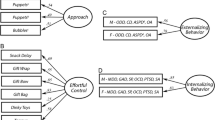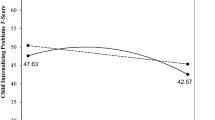Abstract
Effortful control, a temperamentally based ability to inhibit a dominant response and activate a subdominant response, was assessed on 3 occasions using a comprehensive, age-appropriate behavioral battery in this 4-year longitudinal study of children (N = 103) from toddlerhood to early school age. The focus was twofold: to explore the structure of effortful control in a normally developing sample and to examine the relations between effortful control and adaptive functioning. Exploratory factor analyses supported the contention that effortful control is a complex, multidimensional construct with longitudinally stable factors. Effortful control was also significantly associated with mother-reported total behavior problems in a nonlinear fashion, with lower and higher levels of effortful control contributing to higher total problem scores. These findings have implications for the assessment of temperament in children and, most importantly, for the study of nonlinear contributions of temperament to early childhood behaviors.
Similar content being viewed by others
REFERENCES
Achenbach, T. M., & Edelbrock, C. S. (1983). Manual for the child behavior checklist and revised child behavior profile. Burlington: University of Vermont, Department of Psychiatry.
Barkley, R. A. (1990). Attention deficit hyperactivity disorder: A handbook for diagnosis and treatment. New York: Guilford.
Barkley, R. A. (1997). Behavioral inhibition, sustained attention, and executive function: Constructing a unifying theory of ADHD. Psychological Bulletin, 121, 65-94.
Biederman, J., Hirshfeld-Becker, D. R., Rosenbaum, J. F., Herot, C., Friedman, D., Snidman, N., et al. (2001). Further evidence of association between behavioral inhibition and social anxiety in children. American Journal of Psychiatry, 158, 1673-1679.
Block, J. H., & Block, J. (1980). The role of ego-control and ego-resiliency in the organization of behavior. In W. A. Collins (Ed.), The Minnesota symposia on child psychology (Vol. 13, pp. 39-101). Hillsdale, NJ: Erlbaum.
Block, J., Block, J. H., & Keyes, S. (1988). Longitudinally foretelling drug use in adolescence: Early childhood personality and environmental precursors. Child Development, 59, 336-355.
Campbell, S. B. (1995). Behavior problems in preschool children: A review of recent research. Journal of Child Psychology and Psychiatry and Allied Disciplines, 36, 113-149.
Campbell, S. B., Szumowski, E. K., Ewing, L. J., Gluck, D. S., & Breaux, A. M. (1982). A multidimensional assessment of parent-identified behavior problem toddlers. Journal of Abnormal Child Psychology, 10, 569-592.
Chorpita, B. F., Albano, A. M., & Barlow, D. H. (1998). The structure of negative emotions in a clinical sample of children and adolescents. Journal of Abnormal Psychology, 107, 74-85.
Derryberry, D., & Rothbart, M. K. (1997). Reactive and effortful processes in the organization of temperament. Development and Psychopathology, 9, 633-652.
Dodge, K. A., & Newman, J. P. (1981). Biased decision-making processes in aggressive boys. Journal of Abnormal Psychology, 90, 375-379.
Douglas, V I. (1988). Cognitive deficits in children with attention deficit disorder with hyperactivity. In L. M. Bloomingdale & J. A. Sergeant (Eds.), Attention deficit disorder: Criteria, cognition, intervention (pp. 65-82). London: Pergamon.
Eisenberg, N., & Fabes, R. A. (1992). Emotion, regulation, and the development of social competence. In M. S. Clark (Ed.), Emotion and social behavior: Review of personality and social psychology (Vol. 14, pp. 119-150). Newbury Park, CA: Sage.
Fowles, D. C. (1994). A motivational theory of psychopathology. In W. Spaulding (Ed.), Nebraska symposium on motivation: Vol. 41. Integrated views of motivation and emotion (pp. 181-228). Lincoln: University of Nebraska Press.
Funder, D. C., & Block, J. (1989). Delay of gratification: Some longitudinal personality correlates. Journal of Personality and Social Psychology, 44, 1198-1213.
Gerbing, D. W., Ahadi, S. A., & Patton, J. H. (1987). Toward a conceptualization of impulsivity: Components acrosss the behavioral and self-report domains. Multivariate Behavioral Research, 22, 357-379.
Huey, S. J., Jr., & Weisz, J. R. (1997). Ego control, ego resiliency, and the five-factor model as predictors of behavioral and emotional problems in clinic-referred children and adolescents. Journal of Abnormal Psychology, 106, 404-415.
Kagan, J., Reznick, J. S., & Snidman, N. (1987). The physiology and psychology of behavioral inhibition in children. Child Development, 58, 1459-1473.
Kagan, J., Rosman, B. L., Day, D., Albert, J., & Phillips, W. (1964). Information-processing in the child: Significance of analytic and reflective attitudes. Psychological Monographs, 78 (whole No. 578).
Keenan, K., & Wakschlag, L. S. (2002). Can a valid diagnosis of disruptive behavior disorder be made in preschool children? The American Journal of Psychiatry, 159, 351-358.
Kindlon, D., Mezzacappa, E., & Earls, F. (1995). Psychometric properties of impulsivity measures: Temporal stability, validity, and factor structure. Journal of Child Psychology and Psychiatry, 36, 645-651.
Kochanska, G., & Aksan, N. (1995). Mother-child mutually positive affect, the quality of child compliance to requests and prohibitions, and maternal control as correlates of early internalization. Child Development, 66, 236-254.
Kochanska, G., Murray, K., & Coy, K. C. (1997). Inhibitory Control as a contributor to conscience in childhood: From toddler to early school age. Child Development, 68, 263-277.
Kochanska, G., Murray, K. T., & Harlan, E. T. (2000). Effortful control in early childhood: Continuity and change, antecedents, and implications for social development. Developmental Psychology, 36, 220-232.
Kochanska, G., Murray, K., Jacques, T. Y., Koenig, A. L., & Vandegeest, K. (1996). Inhibitory control in young children and its role in emerging internalization. Child Development, 67, 490-507.
Kopp, C. B. (1982). Antecedents of self-regulation: A developmental perspective. Developmental Psychology, 18, 199-214.
Kopp, C. B. (1989). Regulation of distress and negative emotions: A developmental view. Developmental Psychology, 25, 343-354.
Krueger, R. F., Caspi, A., Moffitt, T. E., White, J. L., & Stouthamer-Loeber, M. (1996). Delay of gratification, psychopathology, and personality: Is low self-control specific to externalizing problems? Journal of Personality, 64, 107-129.
Lahey, B. B., Vosk, B. N., & Habif, V. L. (1981). Behavioral assessment of learning-disabled children: A rationale and strategy. Behavioral Assessment, 3, 3-14.
Lytton, H. (1980). Parent-child interaction: The socialization processes observed in twin and singleton families. New York: Plenum.
Maccoby, E. E., Dowley, E., Hagen, J., & Degerman, R. (1965). Activity level and intellectual functioning of normal preschool children. Child Development, 36, 761-770.
Marakovitz, S. E., & Campbell, S. B. (1998). Inattention, impulsivity, and hyperactivity from preschool to school age: Performance of hard-to-manage boys on laboratory measures. Journal of Child Psychology and Psychiatry and Allied Disciplines, 39, 841-851.
Milich, R., & Kramer, J. (1984). Reflections on impulsivity: An empirical investigation of impulsivity as a construct. Advances in Learning and Behavioral Disabilities, 3, 57-94.
Milich, R., & Landau, S. (1982). Socialization and peer relations in hyperactive children. In K. Gadow & I. Bialer (Eds.), Advances in learning and behavioral disabilities (Vol 1). Greenwich, CT: JAI Press.
Moffitt, T. E. (1990). Juvenile delinquency and attention deficit disorder: Boys' developmental trajectories from age 3 to age 15. Child Development, 61, 893-910.
Newman, J. P., & Wallace, J. F. (1993). Diverse pathways to deficient self-regulation: Implications for disinhibitory psychopathology in children. Clinical Psychology Review, 13, 690-720.
Nigg, J. T. (2000). On inhibition/disinhibition in developmental psychopathology: Views from cognitive and personality psychology and a working inhibition taxonomy. Psychological Bulletin, 126, 220-246.
Olson, S. L. (1989). Assessment of impulsivity in preschoolers: Cross-measure convergences, longitudinal stability, and relevance to social competence. Journal of Clinical Child Psychology, 18, 176-183.
Olson, S. L., Bates, J. E., & Bayles, K. (1990). Early antecedents of childhood impulsivity: The role of parent-child interaction, cognitive competence, and temperament. Journal of Abnormal Child Psychology, 18, 317-334.
Olson, S. L., Schilling, E. M., & Bates, J. E. (1999). Measurement of impulsivity: Construct coherence, longitudinal stability, and relationship with externalizing problems in middle childhood and adolescence. Journal of Abnormal Child Psychology, 27, 151-165.
Patterson, C. M., Kosson, D. S., & Newman, J. P. (1987). Reaction to punishment, reflectivity, and passive avoidance learning in extraverts. Journal of Personality and Social Psychology, 52, 565-575.
Pelham, W. E., & Bender, M. E. (1982). Peer interactions of hyperactive children: Assessment and treatment. In K. D. Gadow & I. Bialer (Eds.), Advances in learning and behavior difficulties (Vol. 1, pp. 365-436). Greenwich, CT: JAI Press.
Pennington, B. R, & Ozonoff, S. (1996). Executive functions and developmental psychopathology. Journal of Child Psychology and Psychiatry and Allied Disciplines, 37, 51-87.
Pulkinnen, L. (1986). The role of impulse control in the development of antisocial and prosocial behavior. In D. Olweus, J. Block, & M. Radke-Yarrow (Eds.), Development of antisocial and prosocial behavior: Research, theories, and issues. New York: Academic Press.
Pulkinnen, L. (1996). Impulse control in children. Journal of Forensic Psychiatry, 7, 228-233.
Quay, H. C. (1997). Inhibition and attention deficit hyperactivity disorder. Journal of Abnormal Child Psychology, 25, 7-14.
Reed, M. A., Pien, D. L., & Rothbart, M. K. (1984). Inhibitory self-control in preschool children. Merrill-Palmer Quarterly, 30, 131-147.
Robins, R. W., John, O. P., Caspi, A., Moffitt, T. E., & Stouthamer-Loeber, M. (1996). Resilient, overcontrolled, and undercontrolled boys: Three replicable personality types. Journal of Personality and Social Psychology, 70, 157-171.
Rothbart, M. K. (1989). Temperament and development. In G. A. Kohnstamm, J. A. Bates, & M. K. Rothbart (Eds.), Temperament in childhood (pp. 187-247). New York: Wiley.
Rothbart, M. K., & Ahadi, S. (1994). Temperament and the development of personality. Journal of Abnormal Psychology, 103, 55-66.
Rothbart, M. K., Ahadi, S., & Hershey, K. L. (1994). Temperament and social behavior in childhood. Merrill-Palmer Quarterly, 40, 21-29.
Rothbart, M. K., & Bates, J. E. (1998). Temperament. In W. Damon (Series Ed.) & N. Eisenberg (Vol. Ed.), Handbook of child psychology: Vol. 3. Social, emotional, and personality development (5th ed.). New York: Wiley.
Rothbart, M. K., Derryberry, D., & Posner, M. I. (1994). A psychobiological approach to the developments of temperament. In J. E. Bates & T. D. Wachs (Eds.), Temperament: Individual differences in biology and behavior (pp. 83-116). Washington, DC: American Psychological Association.
Rushton, J. P., Brainerd, C. J., & Pressley, M. (1983). Behavioral development and construct validity: The principle of aggregation. Psychological Bulletin, 94, 18-38.
Schachar, R. J., Tannock, R., & Logan, G. (1993). Inhibitory control, impulsiveness, and attention deficit hyperactivity disorder. Clinical Psychology Review, 13, 721-739.
Vaughn, B. E., Kopp, C. B., & Krakow, J. B. (1984). The emergence and consolidation of self-control from eighteen to thirty months of age: Normative trends and individual differences. Child Development, 55, 990-1004.
White, J. L., Moffitt, T. E., Caspi, A., Bartusch, D. J., Needles, D. J., & Stouthamer-Loeber, M. (1994). Measuring impulsivity and examining its relationship to delinquency. Journal of Abnormal Psychology, 103, 192-205.
Wright, J. C. (1971). KRISP (Kansas Reflection-Impulsivity Scale for Preschoolers). University of Kansas, Lawrence.
Author information
Authors and Affiliations
Corresponding author
Rights and permissions
About this article
Cite this article
Murray, K.T., Kochanska, G. Effortful Control: Factor Structure and Relation to Externalizing and Internalizing Behaviors. J Abnorm Child Psychol 30, 503–514 (2002). https://doi.org/10.1023/A:1019821031523
Issue Date:
DOI: https://doi.org/10.1023/A:1019821031523




